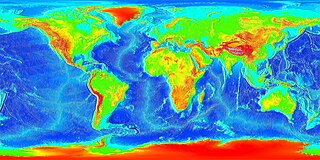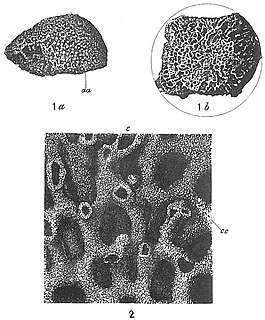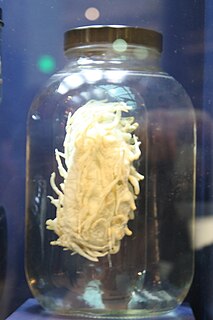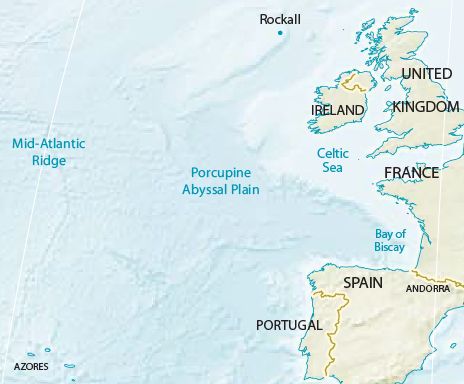
Xenophyophorea is a clade of foraminiferans. Members of this class are multinucleate unicellular organisms found on the ocean floor throughout the world's oceans, at depths of 500 to 10,600 metres. They are a kind of foraminiferan that extracts minerals from their surroundings and uses them to form an exoskeleton known as a test.
The pelagic zone consists of the water column of the open ocean, and can be further divided into regions by depth. The word "pelagic" is derived from Ancient Greek πέλαγος (pélagos), meaning 'open sea'. The pelagic zone can be thought of in terms of an imaginary cylinder or water column that goes from the surface of the sea almost to the bottom. Conditions in the water column change with distance from the surface (depth): the pressure increases; the temperature and amount of light decreases; the salinity and amount of dissolved oxygen, as well as micronutrients such as iron, magnesium and calcium, all change. Rather like the Earth's atmosphere, but depending on how deep the water is, the water column can be divided vertically into up to five different layers, as illustrated on the right.

An abyssal plain is an underwater plain on the deep ocean floor, usually found at depths between 3,000 metres (9,800 ft) and 6,000 metres (20,000 ft). Lying generally between the foot of a continental rise and a mid-ocean ridge, abyssal plains cover more than 50% of the Earth's surface. They are among the flattest, smoothest, and least explored regions on Earth. Abyssal plains are key geologic elements of oceanic basins.

The seabed is the bottom of the ocean, no matter how deep. All floors of the ocean are known as 'seabeds'.
The hadal zone, also known as the hadopelagic zone, is the deepest region of the ocean lying within oceanic trenches. The hadal zone is found from a depth of around 6,000 to 11,000 metres, and exists in long but narrow topographic V-shaped depressions.
The Komokiacea are a small group of amoeboid protozoa, considered to be foraminifera, though there have been suggestions that they are a separate group, closely related to foraminifera. Komokiacea are rather large organisms, often exceeding 300 micrometers in maximum dimensions. Along with Xenophyophores they dominate the macro- and megabenthic fauna in the deep sea and are commonly referred to as "giants protists".

The habitat of deep-water corals, also known as cold-water corals, extends to deeper, darker parts of the oceans than tropical corals, ranging from near the surface to the abyss, beyond 2,000 metres (6,600 ft) where water temperatures may be as cold as 4 °C (39 °F). Deep-water corals belong to the Phylum Cnidaria and are most often stony corals, but also include black and horny corals and soft corals including the Gorgonians. Like tropical corals, they provide habitat to other species, but deep-water corals do not require zooxanthellae to survive.

A deep sea community is any community of organisms associated by a shared habitat in the deep sea. Deep sea communities remain largely unexplored, due to the technological and logistical challenges and expense involved in visiting this remote biome. Because of the unique challenges, it was long believed that little life existed in this hostile environment. Since the 19th century however, research has demonstrated that significant biodiversity exists in the deep sea.

Psilaster andromeda is a species of starfish in the family Astropectinidae. It is native to the northeastern Atlantic Ocean where it occurs at abyssal depths.

Hotspot Ecosystem Research and Man's Impact On European Seas (HERMIONE) is an international multidisciplinary project, started in April 2009, that studies deep-sea ecosystems. HERMIONE scientists study the distribution of hotspot ecosystems, how they function and how they interconnect, partially in the context of how these ecosystems are being affected by climate change and impacted by humans through overfishing, resource extraction, seabed installations and pollution. Major aims of the project are to understand how humans are affecting the deep-sea environment and to provide policy makers with accurate scientific information, enabling effective management strategies to protect deep sea ecosystems. The HERMIONE project is funded by the European Commission's Seventh Framework Programme, and is the successor to the HERMES project, which concluded in March 2009.

Syringammina is a xenophyophore found off the coast of Scotland, near Rockall. It is the largest single-celled organism known, at up to 20 centimetres (8 in) across. It was first described in 1882 by the oceanographer John Murray, after being discovered on an expedition in the ship Triton which dredged the deep ocean bed off the west coast of Scotland in an effort to find organisms new to science. It was the first xenophyophore to be described and at first its relationship with other organisms was a mystery, but it is now considered to be a member of the Foraminifera.

BENGAL was the acronym of the research project High-resolution temporal and spatial study of the BENthic biology and Geochemistry of a north-eastern Atlantic abyssal Locality. The project was funded through the EC MAST III program from 1996 to 1998.

Oneirophanta mutabilis is a species of sea cucumbers in the family Deimatidae. It is the type species of the genus Oneirophanta. It is found on the seabed at abyssal depths. It was first described by the Swedish zoologist Hjalmar Théel in 1879, being one of the many deep sea animals discovered during the Challenger expedition of 1872–1876.
Amperima rosea is a species of sea cucumber in the family Elpidiidae. It is found on the seabed at abyssal depths of 4,000 m (2.5 mi) or more. Around 1996, its numbers in the Porcupine Abyssal Plain in the northeastern Atlantic increased dramatically from a few individuals per hectare to over six thousand per hectare, a phenomenon that became known as the "Amperima event".

Molpadia musculus is a species of sea cucumber in the family Molpadiidae. It is found in deep waters in the Atlantic Ocean, burrowing in the mud.
Thyone fusus is a species of sea cucumber in the family Phyllophoridae. It is found on the seabed in the northeastern Atlantic Ocean and the Mediterranean Sea. It is a suspension feeder and catches food particles floating past with its branching feeding tentacles.
Madeira Abyssal Plain, also called Madeira Plain, is an abyssal plain situated at the center and deepest part of the Canary Basin. It is a north-northeast to south-southeast elongated basin that almost parallels the Mid-Atlantic Ridge. Its western boundary is marked by a chain of seamounts known as the either Seewarte Seamounts or Atlantis-Great Meteor Seamount Chain. Its eastern boundary is a distinct break of slope that marks the foot of the African Continental Rise. This abyssal plain occupies an area of about 68,000 km2 (26,000 sq mi). Across this basin, slope angles are generally less than 0.01°.

Imants (Monty) George Priede is a British-Latvian zoologist, author and academic. He is Professor Emeritus in the University of Aberdeen, Scotland known for his work on fish and life in the deep sea.

Occultammina is a genus of xenophyophorean foraminifera known from the Atlantic and Pacific oceans. It is notable for being the first known infaunal xenophyophore as well as for being a possible identity for the enigmatic trace fossil Paleodictyon.













